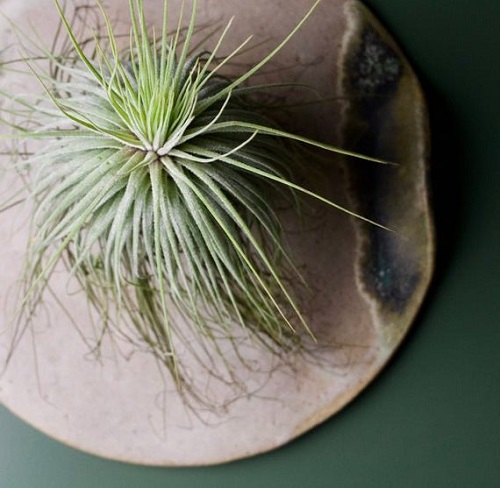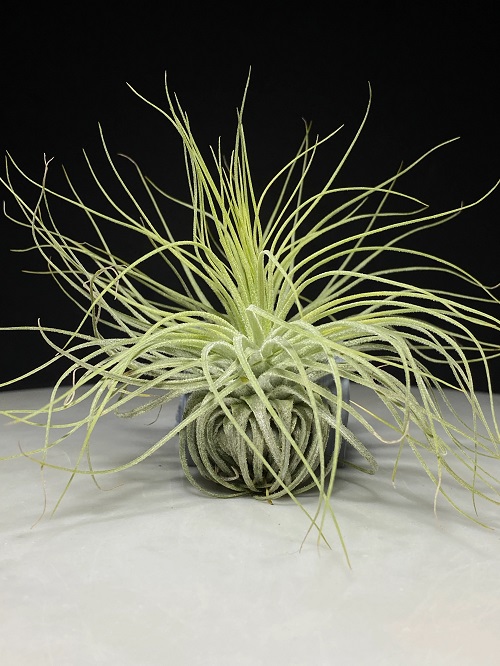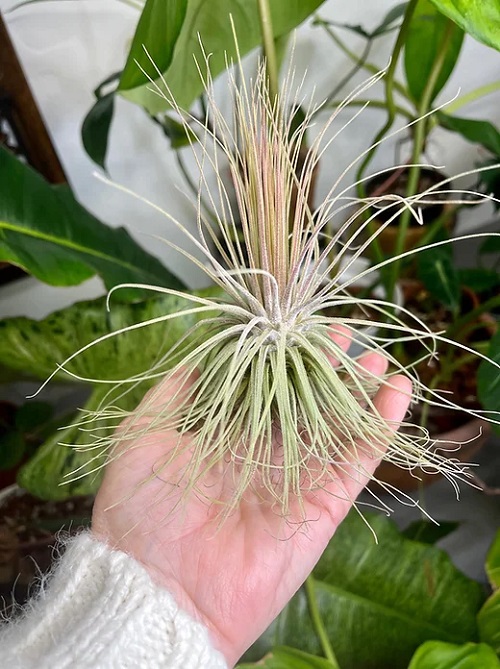Read this Tillandsia Magnusiana Care and Growing guide with expert tips for nurturing this epiphyte in your home.
Explore this Tillandsia Magnusiana Care and Growing guide for including this beautiful plant in your home. Whether you’re new to plants or an experienced gardener, these tips will show you the easy steps to nurture and help your Tillandsia flourish.
- Botanical Name: Tillandsia Magnusiana
- Common Name: Poor Man’s Tectorum
- Thrives in full sun
Find Where Do Air Plants Come From
What is the Tillandsia Magnusiana

In its natural habitat, Tillandsia Magnusiana produces vibrant pink to purple flowers, adding a splash of color to its surroundings. The flowers emerge from the center of the rosette and can last for several weeks. The foliage is covered in trichomes, tiny hair-like structures that allow the plant to absorb moisture and nutrients from the air. This unique feature makes it an epiphytic plant, which means it doesn’t require soil to grow.
Read How Long Do Air Plants Live
Tillandsia Magnusiana Propagation
Methods to propagate Tillandsia Magnusiana:
- Offsets/Pups
- Seed Propagation
Easiest Method: Offsets/Pups
Tillandsia Magnusiana can be easily propagated through offsets or pups. These are small offshoots that develop at the base of the parent plant. Follow these steps to propagate using offsets:
- Identify Healthy Offsets: Wait until the offset is about one-third the size of the parent plant and has its own set of roots.
- Separate the Offset: Gently grasp the offset near its base and wiggle it to detach it from the parent plant. Be careful not to damage the roots.
- Allow Drying: Place the separated offset in a dry, shaded spot for a day or two. This step helps to prevent rot during the next phase.
- Mounting: Instead of using soil, air plants are typically mounted on various surfaces. You can attach the offset to a piece of wood, a decorative rock, or any other creative substrate. Use waterproof glue, wire, or even natural materials like cotton thread to secure the offset to the chosen surface.
- Mist and Wait: Mist the offset and its surroundings lightly to provide a bit of moisture. Over the next few weeks, the offset will start growing its own roots and establishing itself.
- Regular Care: Treat the newly planted offset the same way you care for mature Tillandsia Magnusiana, providing proper light, air circulation, and occasional misting or soaking.
Offsets are a reliable and simple way to propagate Tillandsia Magnusiana and usually have a high success rate. This method allows you to enjoy more of these unique air plants in your collection or share them with fellow plant enthusiasts.
Explore the Amazing Benefits of Air Plants
Tillandsia Magnusiana Flower
The Tillandsia Magnusiana flower is a vibrant and eye-catching feature of this air plant. Emerging in hues of pink to purple, it adds a splash of color to the plant’s silver-green foliage. The flowers arise from the center of the rosette, lasting for weeks and enhancing the plant’s distinct appearance.
Pot for Tillandsia Magnusiana

Find Do Air Plants Need Sun?
How to Display Tillandsia Magnusiana
 1. Choosing a Display Method:
1. Choosing a Display Method:
Select a display method that suits your space and style. Options include hanging, mounting, and placing on various surfaces.
2. Hanging Display:
Attach a string or fishing line to the plant’s base using a gentle loop. Hang it from a hook, curtain rod, or ceiling. This method allows the plant to dangle gracefully, showing off its distinctive shape.
3. Mounting on a Base:
Secure the Tillandsia to a decorative base such as driftwood, cork bark, or decorative rock. Use floral wire or adhesive to affix the plant securely to the base.
4. Creating Terrariums:
Place Tillandsia Magnusiana inside a glass container with an open top. Add decorative elements like stones, shells, or sand to enhance the display. Terrariums provide a unique way to appreciate the plant’s form.
5. Displaying in Glass Orbs:
Suspend Tillandsia Magnusiana inside glass orbs or globes. Ensure the orb has a large enough opening for easy placement and removal of the plant.
6. Wall-Mounted Frames:
Insert Tillandsia into a wire mesh or frame with openings for the plants. Hang it on a wall to create a living piece of art.
7. Tabletop Arrangements:
Place Tillandsia on tabletops, shelves, or windowsills. Use small decorative dishes, trays, or holders to elevate the plant and complement your interior decor.
8. Grouping and Combinations:
Combine Tillandsia Magnusiana with other air plants, succulents, or decorative elements to create visually appealing arrangements.
Learn How to Care for Air Plants
Feeding Tillandsia Magnusiana
As an air plant, Tillandsia Magnusiana doesn’t need soil. Taking care of it means giving it fertilizer every month. Use a Moderate amount of fertilizer. In the summer, it’s good to give a bit of Tillandsia air plant fertilizer once or twice a month. Reduce or skip fertilization during its dormant winter period, focusing on overall care for optimal health.
Tillandsia Magnusiana Care
 Position
Position
Tillandsia Magnusiana thrives best in bright, filtered sunlight. These air plants love ample light and can even grow in very bright and hot places due to their trichomes. Good air movement is also needed for their growth. Remember, young or less sun-exposed T. magnusiana should avoid harsh afternoon sun to prevent sunburn. If the area gets too hot, place your Magnusiana air plant a bit away from the window to get indirect light. Fluorescent lights placed 6 to 36 inches away work well, and you can also consider full-spectrum bulbs or four-tube setups for artificial lighting.
Airflow
Adequate airflow is essential for T. magnusiana. Keeping the plant constantly damp is discouraged. After each watering, ensure the plant gets a few hours of exposure to light and air. This practice not only refreshes the plant but also prevents overheating.
Water
Watering Tillandsia Magnusiana is vital for its well-being. Use room-temperature tap or rainwater, and mist the plant every 1-2 weeks or soak it for 20-30 minutes every 2-4 weeks. Quick drying within 4 hours is crucial to prevent rot. Avoid over-watering, and adjust frequency based on humidity and location. Check the leaves firmness for hydration cues. Special care is needed for mounted plants and during winter. Keeping a balance between hydration and avoiding waterlogged conditions is key to its health.
Temperature
Tillandsia Magnusiana thrives best within temperatures of 50 to 90 °F and cannot endure very cold conditions. It can tolerate brief periods near 0 °C. If your region experiences temperatures below 35 to 45 °F, it’s recommended to keep this plant indoors. These air plants prefer moderate humidity levels and benefit from proper ventilation.
Pests and Diseases
Tillandsia Magnusiana can be affected by pests like mealybugs, aphids, spider mites, and scale insects. Diseases such as rot, fungal infections, and viral infections are also possible. To prevent these issues, maintain good air circulation, avoid over-watering, and regularly inspect the plant. Treat infestations with suitable remedies like insecticidal soap or neem oil, and address diseases by trimming affected parts. Consistent care and vigilant observation are essential for a healthy Tillandsia Magnusiana.
Find What Does a Healthy Air Plant Look Like?
Frequently Asked Questions
Q: Is Tillandsia Magnusiana low-maintenance?
A: Yes, it’s relatively low-maintenance compared to other plants. Regular misting, proper lighting, good air circulation, and occasional fertilization are key to its health.
Q: How do I prevent over-watering?
A: Ensure the plant dries within 4 hours of watering. Avoid letting water pool at the base or in leaf crevices. Adjust the watering frequency based on humidity and environment.
Q: Can I keep Tillandsia Magnusiana outdoors?
A: Yes, but avoid extreme cold temperatures. It can tolerate brief periods near 0 °C. In colder regions, it’s best to bring it indoors during winter.




